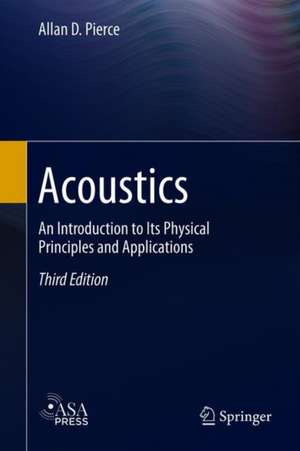Acoustics: An Introduction to Its Physical Principles and Applications
Autor Allan D. Pierceen Limba Engleză Hardback – 8 iul 2019
Since its publication, this text has been used as part of numerous acoustics-related courses across the world, and continues to be used widely today. During its writing, the book was fine-tuned according to insights gleaned from a broad range of classroom settings. Its careful design supports students in their pursuit of a firm foundation while allowing flexibility in course structure. The book can easily be used in single-term or full-year graduate courses and includes problems and answers. This rigorous and essential text is a must-have for any practicing or aspiring acoustician.
Preț: 458.89 lei
Nou
Puncte Express: 688
Preț estimativ în valută:
87.82€ • 91.13$ • 73.40£
87.82€ • 91.13$ • 73.40£
Carte tipărită la comandă
Livrare economică 17-31 martie
Preluare comenzi: 021 569.72.76
Specificații
ISBN-13: 9783030112134
ISBN-10: 3030112136
Pagini: 760
Ilustrații: XLI, 768 p. 218 illus.
Dimensiuni: 155 x 235 x 52 mm
Greutate: 1.3 kg
Ediția:3rd ed. 2019
Editura: Springer International Publishing
Colecția Springer
Locul publicării:Cham, Switzerland
ISBN-10: 3030112136
Pagini: 760
Ilustrații: XLI, 768 p. 218 illus.
Dimensiuni: 155 x 235 x 52 mm
Greutate: 1.3 kg
Ediția:3rd ed. 2019
Editura: Springer International Publishing
Colecția Springer
Locul publicării:Cham, Switzerland
Cuprins
Foreword.- Preface to the Third Edition.- Preface to the First Edition.- About the Author.- List of Symbols.- Chapter 1 The Wave Theory of Sound.- Chapter 2 Quantitative Measures of Sound.- Chapter 3 Reflection, Transmission, and Excitation of Plane Waves.- Chapter 4 Radiation from Vibrating Bodies.- Chapter 5 Radiation from Sources Near and on Solid Surfaces.- Chapter 6 Room Acoustics.- Chapter 7 Low-Frequency Models of Sound Transmission.- Chapter 8 Ray Acoustics.- Chapter 9 Scattering and Diffraction.- Chapter 10 Effects of Viscosity and Other Dissipative Processes.- Chapter 11 Nonlinear Effects in Sound Propagation.- Appendix.- Indexes.- Name Index.- Subject Index.
Notă biografică
Allan D. Pierce was born in 1936 and spent his early years in Iowa, Kansas, and New Mexico. After receiving a Ph.D. in Physics from MIT, he was employed by RAND (1961-1963) and Avco (1963-1966). His work during these years was concerned primarily with the analysis of infrasonic waveforms generated by thermonuclear explosions, and this broadened into a life-long interest in all aspects of physical acoustics, applied mechanics, vibrations, and wave physics. From 1966 to 2012 he held a succession of professorial appointments — at MIT (1966-1973), Georgia Tech (1973-1988), Penn State (1988-1993), and Boston University (1993-2012). He retired from BU in 2012, and founded the Cape Cod Institute for Science and Engineering in 2017. He is a Fellow of the Acoustical Society of America and of the American Society of Mechanical Engineers, and is a recipient of the ASA Silver Medal in Physical Acoustics and the ASA Gold Medal, the ASME Per Bruel Gold Medal, the Rossing Prize for Acoustics Education, and the Gold Medal of the Acoustical Foundation of India. Over the years he has had many editorial positions, including being the founding co-Editor-in-Chief of the Journal of Computational Acoustics and the Editor-in-Chief of the Acoustical Society of America. He was the founding editor of Proceedings of Meetings in Acoustics.
Textul de pe ultima copertă
This corrected version of the landmark 1981 textbook introduces the physical principles and theoretical basis of acoustics with deep mathematical rigor, concentrating on concepts and points of view that have proven useful in applications such as noise control, underwater sound, architectural acoustics, audio engineering, nondestructive testing, remote sensing, and medical ultrasonics.
Since its publication, this text has been used as part of numerous acoustics-related courses across the world, and continues to be used widely today. During its writing, the book was fine-tuned according to insights gleaned from a broad range of classroom settings. Its careful design supports students in their pursuit of a firm foundation while allowing flexibility in course structure. The book can easily be used in single-term or full-year graduate courses and includes problems and answers. This rigorous and essential text is a must-have for any practicing or aspiring acoustician.
Praise for the 1981 edition:
"Without question this volume will take its place among the more prominent texts for advanced courses on fundamental acoustical theory and applications. The student who masters it should have no difficulty facing with assurance the current problems in acoustical technology." — R. Bruce Lindsay, Brown University in The Journal of the Acoustical Society of America
- Features a wealth of end-of-chapter problems and answers
- Written by the former Editor-in-Chief of the Acoustical Society of America
- Represents essential reading for all practicing and aspiring acousticians
- Facilitates instructional flexibility regarding topics covered, length of course, and interests of students
- Includes a new foreword and preface speaking to the book's continuing importance
Caracteristici
Features a wealth of end-of-chapter problems and answers Written by the former Editor-in-Chief of the Acoustical Society of America Represents essential reading for all practicing and aspiring acousticians Facilitates instructional flexibility regarding topics covered, length of course, and interests of students Includes a new foreword and preface speaking to the book's continuing importance
